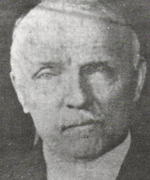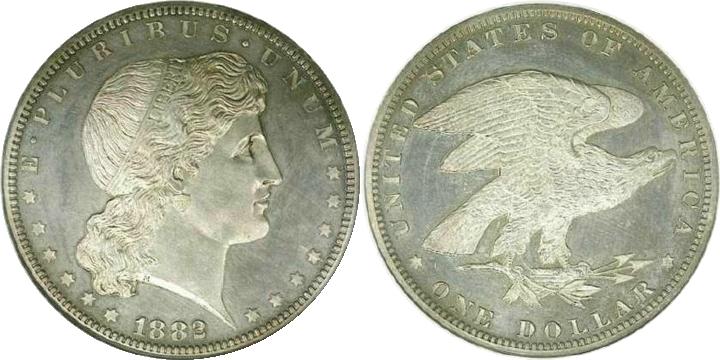 |  | 
  
George
T. Morgan, born in Birmingham, England, in 1845, came to the United
States from England in 1876 and was hired as an assistant engraver at
the Mint in October of that year. He figured very prominently in the
production of pattern coins from 1877 onward. To his hand can be
ascribed some of the most beautiful of all patterns of the 1877-1882
era, including several varieties of 1877 half dollars, the 1879
"Schoolgirl" dollar, and the 1882 "Shield Earring" coins.
As in
the descriptions of the Bass Collection patterns, several references
are made regarding Morgan's ability vs. that of William and Charles
Barber, the following article by Ted Schwarz, "The Morgan and Peace
Silver Dollars," in The Numismatist, November 1975, gives another
numismatic view of the situation while imparting the history of
Morgan's employment:
"Mint Director H.R. Linderman was just as
concerned about [the designs of] the Gobrecht coinage and other designs
in circulation as were the people opposed to the [designs of the]
current specie. He felt that change was needed, but he also felt that
Chief Engraver William Barber, and his assistant, his son Charles, were
overworked and perhaps underqualified. He turned for a solution to the
London Mint and wrote to the director, 'Could you find us a first class
diesinker who would be willing to take the position of Assistant
Engraver at the Mint at Philadelphia? We would like a man who could
produce a finished hub, and if he understood modeling and also bronzing
it would make him more valuable to us. We could pay about $8 per day to
a person of proper qualifications. If you know of such a one who would
be likely to answer our purpose, I will be glad if you will place me in
communication with him.' The reason for turning to the British Mint was
explained at the end of the letter: 'The engraving of coinage and medal
dies has not been brought to much perfection in this country. In
England it appears to have reached a standard equal if not superior to
that of any other country.'
"The director of the London Mint,
Charles W. Fremantle, replied in part, 'My enquiries as to an Assistant
Engraver lead me very strongly to recommend for the post Mr. George
Morgan, aged 30, who has made himself a considerable name, but for whom
there is not much opening at present in this country. I send a letter
from him, to which you will of course reply as you may think best, but
I may perhaps just say that looking to Mr. Morgan's real talent, I do
not think that he wishes to make conditions which are in any way
unreasonable, and that I am convinced you would not find in him any
inclination to take undue advantage of such privilege in regard to
private work & as you may see fit to concede to him. I may add that
he is personally agreeable & gentleman-like, & particularly
modest and quiet in manner, so that he would be likely to make an
agreeable colleague. You will judge of his qualifications by the work
he is sending you, & I can only say that I shall be sorry if we
lose him from this country, while I make no doubt he will be a valuable
acquisition to yours, both officially and as an artist. It has of
course occurred to me that you may think Mr. Morgan too good for the
place you have to offer, but I have a strong opinion that he ought not
to be lost to you on that account, & that you will do well to
secure his services.'
"Morgan's letter described his training
and experience: 'I am familiar with the engraving of coin dies, having
for several years, assisted Messrs. J.S. & A.B. Wyon." I think I
may say that I have a good knowledge of Design & Modeling. I served
an apprenticeship to the Die Sinking at Birmingham. From Birmingham
School of Art I successfully competed for a Scholarship at South
Kensington… during my Studentship I obtained Medals & Prizes for
Models of Heads from Life. Figures from Life & Antique Heads from
Photographs and Flowers from nature. I believe it is not usual for an
Engraver to have a practical knowledge of Bronzing. Fortunately I have
a knowledge of this art and could in a short time so instruct an apt
scholar that he would be able to successfully bronze a medal.'
"Morgan
was indeed hired by the Philadelphia Mint, with the understanding that
William Barber would soon be retired so there would be space for the
British engraver to use for work. The two Barbers shared an office in
the Mint from which they conducted not only government business but
also operated their own private engraving firm. With the Mint's
knowledge they often used business hours for their private enterprise,
wasting the taxpayers' money. The retirement of the senior Barber would
enable him to devote full time to his private engraving firm, while
also freeing half the office space for Morgan.
"In 1878, George
Morgan had a chance to demonstrate his experience and talents. His
coin, a variation of the adopted dollar introduced in 1878, had
Liberty's head sculpted in a classic style. The only complaint against
the design was that Liberty appeared somewhat obese. Charles Barber
also submitted a possible design. However, his version showed Liberty
fat, rather dumpy looking and appearing to have thyroid trouble. It was
far from his best effort. It is interesting to study the reverses of
the early designs of both Morgan and Barber. The Morgan eagle,
supposedly created in imitation of real life, actually seemed more
heraldic in nature while the Barber eagle seemed stately and real.
However, that opinion was not shared by everyone. Morgan used Anna
Williams, a Philadelphia school teacher, for his model of Liberty. He
apparently was enchanted with the woman and called her profile the most
nearly perfect one he had ever encountered. The first of the Morgan
dollars was ironically presented to President Hayes, the man who had
vetoed the act authorizing the coins. The rest began entering
circulation rather fitfully. The coins were generally ignored in the
northern and eastern portions of the United States, but they were
popular in the West and in the South, primarily because the recently
freed slaves felt more secure with such 'hard' money than they did with
the paper dollars commonly used for eastern business transactions."
Additional
information concerning Morgan's coming to America and his relationship
with the Barber family is provided by R.W. Julian in a commentary he
contributed to Bowers, Silver Dollars and Trade Dollars of the United
States: A Complete Encyclopedia:
"The Englishman embarked from
Liverpool on board the Illinois on September 27, 1876, arriving at the
port of Philadelphia 12 days later. The new engraver went directly to
the Mint where he received a friendly welcome from the superintendent,
James Pollock. The Barbers, father and son, were less than pleased to
see Morgan and the reception was correct, but chilly. In the meantime,
Fremantle had sent Linderman a number of non-Morgan English eagle
designs for contemplation. Morgan then traveled to Washington where he
spent a day discussing possible designs for the silver coins with the
director. Linderman favored a return to the female head of Liberty as
seen on the coinage prior to 1836 and also a strong eagle on the
reverse. Morgan well understood that Dr. Linderman would be looking
over his shoulder at every step, controlling the exact form the new
designs were to take.
"Upon his return to Philadelphia, Morgan
was curtly informed by Chief Engraver William Barber that there was no
room in the Mint for him to work, and the modeling would have to be
done elsewhere. It is true that the Mint was cramped for space in 1876,
but Barber could have found room for the new engraver had it been
necessary. (Linderman eventually ordered that this be done.) In the
meantime Morgan did much of the work at 3727 Chestnut Street, a rooming
house that was one of several places where he stayed after his arrival
in America. Morgan enrolled at the Academy of Fine Arts to enrich his
knowledge of American art as well as to meet others in his field. It
was at about this time that he was introduced by Thomas Eakins,
Philadelphia artist, to Anna Willess Williams, a local teacher. Morgan
persuaded her, with some difficulty, to pose for the Liberty head that
Linderman wanted for his silver coinage. According to an article in The
Numismatist of May 1896, there were five sittings in November 1876. The
original designs were intended for use on the half dollar. At the time,
no coinage of silver dollars was contemplated."
Following Chief
Engraver William Barber's death in 1879, Morgan hoped that he would be
named to the post. However, the nod went to Barber's son Charles, a man
of relatively few talents in the engraving field. Charles Barber
remained in the position for many years, until his death on February
18, 1917. Subsequently, Morgan became chief engraver, but this was late
in his life, and his "glory years" had already been spent in a
secondary position. He remained chief engraver until his death on
January 4, 1925.
The Numismatist, February 1925, carried his obituary:
"George
T. Morgan, chief engraver for the Philadelphia Mint, died suddenly on
January 4 at his home, 6230 McCallum Street, Germantown. He was 79
years old. Despite his advanced years Mr. Morgan had been active until
a few days before his death, when he became ill. Prior to that he had
been engaged in modeling a series of medals in commemoration of the
secretaries of the Treasury of the United States from Alexander
Hamilton down. Mr. Morgan had made the models for and engraved medals
commemorating the administration of every president since Rutherford B.
Hayes. He collaborated with the country's noted sculptors in designing
the country's coinage and, to a considerable extent, in adapting such
models to use on postage stamps of all denominations. His work made him
personally known to all the presidents of recent times. His employment
by the United States government in the Philadelphia Mint covered a
period of 48 years. The famous Bland silver dollar was one of his coin
engravings. His initials appeared on a large proportion of all the
coins issued in the last quarter of a century or more by the Mint. Born
in Birmingham, England, in 1845, he studied at art schools in that
country, and came to Philadelphia to enter the Engraving Department of
the Mint. He brought with him the Englishman's love of cricket as a
sport and was one of the founders of the old Belmont Cricket Club in
West Philadelphia. He retained his interest in the game to the last and
was an active member of the Germantown Cricket Club. He was a man of
striking physique and his years sat lightly on him. He was a life
member of the Philadelphia Academy of the Fine Arts and a member of the
Sketch Club. He was for many years a vestryman of Christ Protestant
Episcopal Church, Germantown, and superintendent of its Sunday school.
He is survived by his widow and three children-Miss Phyllis Morgan,
Leonard P. Morgan, who is an electrolytic chemist in the United States
Assay Office at New York, and Mrs. C.M. Graham."
In addition to
his many pattern coins, Morgan is particularly remembered for his
famous "Morgan dollar" which was struck for circulation from 1878 to
1921 and several commemorative coins, plus a vast production of medals.
The following is an example of one of Morgan's most famous patterns - J1702/P1904 - the shield earring design.

Image of George Morgan courtesy of Heritage.
|
|

